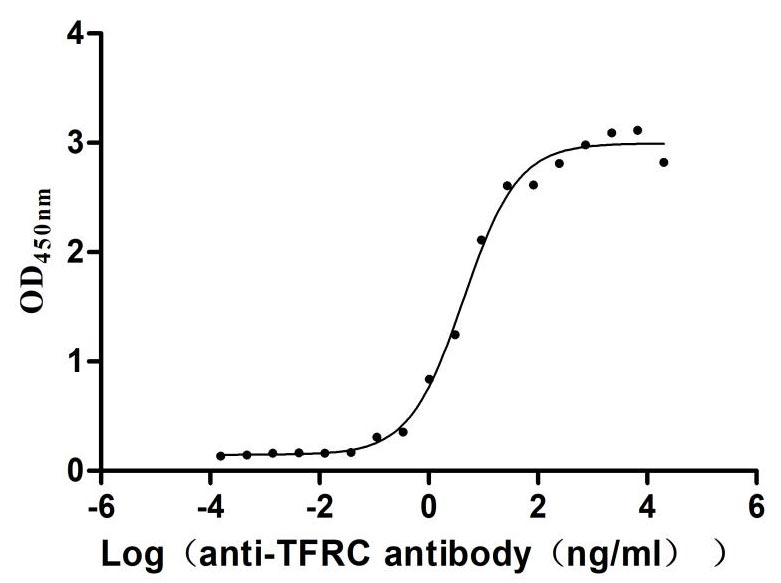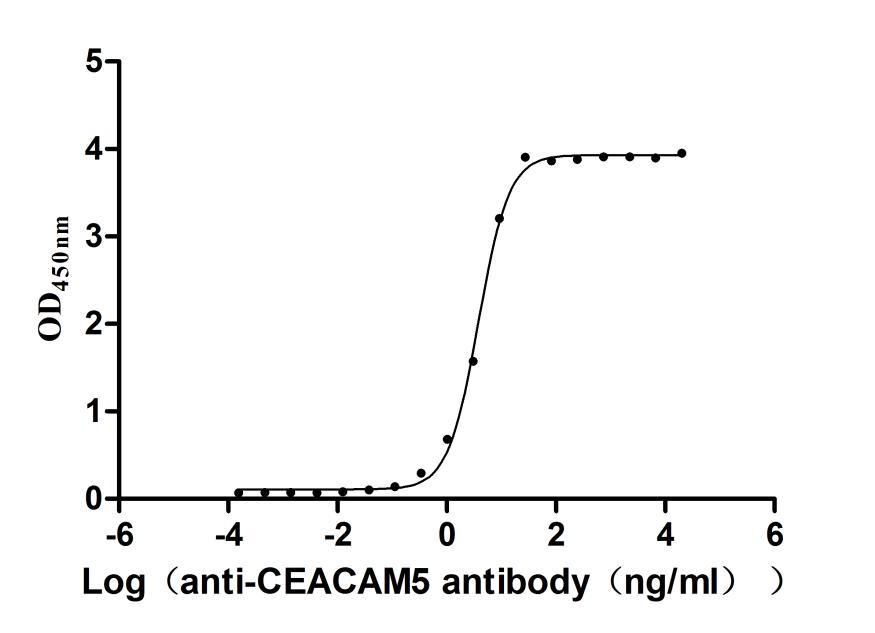Recombinant Human Grainyhead-like protein 3 homolog (GRHL3)
-
中文名称:人GRHL3重组蛋白
-
货号:CSB-YP844730HU
-
规格:
-
来源:Yeast
-
其他:
-
中文名称:人GRHL3重组蛋白
-
货号:CSB-EP844730HU
-
规格:
-
来源:E.coli
-
其他:
-
中文名称:人GRHL3重组蛋白
-
货号:CSB-EP844730HU-B
-
规格:
-
来源:E.coli
-
共轭:Avi-tag Biotinylated
E. coli biotin ligase (BirA) is highly specific in covalently attaching biotin to the 15 amino acid AviTag peptide. This recombinant protein was biotinylated in vivo by AviTag-BirA technology, which method is BriA catalyzes amide linkage between the biotin and the specific lysine of the AviTag.
-
其他:
-
中文名称:人GRHL3重组蛋白
-
货号:CSB-BP844730HU
-
规格:
-
来源:Baculovirus
-
其他:
-
中文名称:人GRHL3重组蛋白
-
货号:CSB-MP844730HU
-
规格:
-
来源:Mammalian cell
-
其他:
产品详情
-
纯度:>85% (SDS-PAGE)
-
基因名:GRHL3
-
Uniprot No.:
-
别名:Drosophila; Grainyhead like 3; Grainyhead like protein 3 homolog; Grainyhead-like protein 3 homolog; grhl3; GRHL3_HUMAN; Sister of mammalian grainyhead; Sister of mammalian grainyhead protein; SOM; TFCP2L4; Transcription factor CP2 like 4; Transcription factor CP2-like 4
-
种属:Homo sapiens (Human)
-
蛋白长度:full length protein
-
表达区域:1-626
-
氨基酸序列MSNELDFRSV RLLKNDPVNL QKFSYTSEDE AWKTYLENPL TAATKAMMRV NGDDDSVAAL SFLYDYYMGP KEKRILSSST GGRNDQGKRY YHGMEYETDL TPLESPTHLM KFLTENVSGT PEYPDLLKKN NLMSLEGALP TPGKAAPLPA GPSKLEAGSV DSYLLPTTDM YDNGSLNSLF ESIHGVPPTQ RWQPDSTFKD DPQESMLFPD ILKTSPEPPC PEDYPSLKSD FEYTLGSPKA IHIKSGESPM AYLNKGQFYP VTLRTPAGGK GLALSSNKVK SVVMVVFDNE KVPVEQLRFW KHWHSRQPTA KQRVIDVADC KENFNTVEHI EEVAYNALSF VWNVNEEAKV FIGVNCLSTD FSSQKGVKGV PLNLQIDTYD CGLGTERLVH RAVCQIKIFC DKGAERKMRD DERKQFRRKV KCPDSSNSGV KGCLLSGFRG NETTYLRPET DLETPPVLFI PNVHFSSLQR SGGAAPSAGP SSSNRLPLKR TCSPFTEEFE PLPSKQAKEG DLQRVLLYVR RETEEVFDAL MLKTPDLKGL RNAISEKYGF PEENIYKVYK KCKRGETSLL HPRLSRHPPP DCLECSHPVT QVRNMGFGDG FWRQRDLDSN PSPTTVNSLH FTVNSE
-
蛋白标签:Tag type will be determined during the manufacturing process.
The tag type will be determined during production process. If you have specified tag type, please tell us and we will develop the specified tag preferentially. -
产品提供形式:Lyophilized powder
Note: We will preferentially ship the format that we have in stock, however, if you have any special requirement for the format, please remark your requirement when placing the order, we will prepare according to your demand. -
复溶:We recommend that this vial be briefly centrifuged prior to opening to bring the contents to the bottom. Please reconstitute protein in deionized sterile water to a concentration of 0.1-1.0 mg/mL.We recommend to add 5-50% of glycerol (final concentration) and aliquot for long-term storage at -20℃/-80℃. Our default final concentration of glycerol is 50%. Customers could use it as reference.
-
储存条件:Store at -20°C/-80°C upon receipt, aliquoting is necessary for mutiple use. Avoid repeated freeze-thaw cycles.
-
保质期:The shelf life is related to many factors, storage state, buffer ingredients, storage temperature and the stability of the protein itself.
Generally, the shelf life of liquid form is 6 months at -20°C/-80°C. The shelf life of lyophilized form is 12 months at -20°C/-80°C. -
货期:Delivery time may differ from different purchasing way or location, please kindly consult your local distributors for specific delivery time.Note: All of our proteins are default shipped with normal blue ice packs, if you request to ship with dry ice, please communicate with us in advance and extra fees will be charged.
-
注意事项:Repeated freezing and thawing is not recommended. Store working aliquots at 4°C for up to one week.
-
Datasheet :Please contact us to get it.
相关产品
靶点详情
-
功能:Transcription factor playing important roles in primary neurulation and in the differentiation of stratified epithelia of both ectodermal and endodermal origin. Binds directly to the consensus DNA sequence 5'-AACCGGTT-3' acting as an activator and repressor on distinct target genes. xhibits functional redundancy with GRHL2 in epidermal morphogenetic events and epidermal wound repair. Exhibits functional redundancy with GRHL2 in epidermal morphogenetic events and epidermal wound repair but is essential to form the epidermal barrier with TGM3 as critical direct target gene among others. Despite being dispensable during normal epidermal homeostasis in the adulthood, is again required for barrier repair after immune-mediated epidermal damage, regulates distinct gene batteries in embryonic epidermal differentiation and adult epidermal barrier reformation after injury. Plays unique and cooperative roles with GRHL2 in establishing distinct zones of primary neurulation. Essential for spinal closure, functions cooperatively with GRHL2 in closure 2 (forebrain/midbrain boundary) and posterior neuropore closure. Also required for proper development of the oral periderm. No genetic interaction with GRHL3, no functional cooperativity due to diverse target gene selectivity.
-
基因功能参考文献:
- Non-melanoma skin cancer growth is accompanied by coordinated reduced expression of epidermal differentiation genes: GRHL1 and GRHL3, which may be regulated by miR-21-3p and -5p, respectively. Some potentially damaging single nucleotide polymorphisms in GRHL genes occur with altered frequencies in NMSC patients, and they may in particular impair the expression of GRHL3 gene or functioning of encoded protein PMID: 29301499
- The down-regulation of GRHL3 in vitro could inhibit colorectal cancer cell activity and trigger cell cycle arrest at G0/G1 phase and apoptosis. PMID: 29270747
- The data suggest that IRF6, TFAP2A, and GRHL3, among others, are shared in neural tube and orofacial development. PMID: 27933721
- Comparison of the variant rate between our cohort and the ExAC database identified a significant enrichment of deleterious variants in GRHL3 in the whole gene and the transactivation region in spina bifida patients. These data provide strong evidence for a role of GRHL3 as a predisposing factor to spina bifida and will help dissect the complex etiology and pathogenic mechanisms of these malformations PMID: 28276201
- mutations contribute to the risk of nonsyndromic cleft palate only in the African population PMID: 28886269
- All of these processes involve epithelial-mesencyhmal transition (EMT), MET or a sequence of both, suggesting that the GRHL factors((GRHL1, GRHL2 and GRHL3), could potentially affect tumor initiation and progression via EMT PMID: 28714958
- No association found between two GRHL3 SNPs (rs2486668 and rs545809) and non-syndromic orofacial clefts in the Han Chinese cohort. PMID: 27459192
- ey epidermal differentiation transcription factor genes, including GRHL3, are located within super-enhancers, and many of these transcription factors in turn bind to and regulate super-enhancers. PMID: 28445475
- GRHL3 expression may be useful as a prognostic factor. PMID: 26797800
- Study genotyped 10 tag SNPs covering GRHL3 and performed association analysis with nonsyndromic cleft lip with or without cleft palate in 504 cases and 455 healthy controls; preliminary results identified rs10903078, rs4638975, and a haplotype rs10903078-rs6659209 of GRHL3 that exceeded the significance threshold (p<0.05), though none survived Bonferroni correction for multiple comparisons. PMID: 27129939
- findings define a major role for Grhl3 in the induction of migration and invasion by the downregulation of E-cadherin in cancer cells PMID: 26837418
- We discovered a genome-wide significant association with a missense variant in GRHL3 and replicated the result in an independent sample of case and control subjects. In both samples, rs41268753 conferred increased risk for cleft palate. PMID: 27018472
- We identified both rare dominant mutations and a common risk variant in the coding region of GRHL3 as causative in individuals with nonsyndromic cleft palate only. PMID: 27018475
- GRHL1, GRHL2, and GRHL3 have roles in cellular proliferation, differentiation, adhesion, and polarity and may promote cancer or be tumor suppressors [review] PMID: 26069269
- We defined a novel molecular signature in mammalian HNSCC, suggesting new treatment strategies targeting the GRHL3/GSK3B/c-MYC proto-oncogenic network. PMID: 26063791
- our results indicate predominant GRHL3 expression in breast cancers PMID: 24363083
- Our data demonstrated that mutations in two genes, IRF6 and GRHL3, can lead to nearly identical phenotypes of orofacial cleft. PMID: 24360809
- The splice variant-derived isoforms SOM1 and SOM3 induce opposing effects in primary human endothelial cells and in a whole animal model, most likely through the induction of different target genes. PMID: 23685552
- decreased Grhl3 expression contributes to tumor progression and upregulation of the oncomir miR-21 in squamous cell carcinoma of the skin. PMID: 22614019
- In human keratinocytes, IRF6 bound conserved elements near the GRHL3 promoter, with one of these elements having enhancer activity. PMID: 22931925
- we define a previously unknown role for the transcription factor GRHL3 in the recruitment of a trxG complex to promoters of genes, leading to increased H3K4 methylation and gene expression PMID: 22829784
- loss of GRHL3 may result in endothelial dysfunction in vivo. PMID: 21856281
- Data report the identification of Sister-of-Mammalian Grainyhead (SOM), which is phylogenetically aligned with grainyhead protein, and like grainyhead encodes a highly conserved developmental transcription factor. [Sister-of-Mammalian Grainyhead] PMID: 12549979
- GRHL3 strongly stimulated primary endothelial cell migration, suggesting that it is a putative tumor-angiogenesis factor. PMID: 18814840
显示更多
收起更多
-
相关疾病:Van der Woude syndrome 2 (VWS2)
-
亚细胞定位:Nucleus.
-
蛋白家族:Grh/CP2 family, Grainyhead subfamily
-
组织特异性:Expressed in brain, colon, pancreas, placenta and kidney. Isoform 1 is expressed in lung and tonsil. Isoform 2 is prostate-specific.
-
数据库链接:
HGNC: 25839
OMIM: 606713
KEGG: hsa:57822
STRING: 9606.ENSP00000288955
UniGene: Hs.657920
Most popular with customers
-
Recombinant Human Tumor necrosis factor ligand superfamily member 18 (TNFSF18), partial (Active)
Express system: Mammalian cell
Species: Homo sapiens (Human)
-
Recombinant Human Pro-neuregulin-1, membrane-bound isoform (NRG1), partial (Active)
Express system: Mammalian cell
Species: Homo sapiens (Human)
-
Recombinant Human B-lymphocyte antigen CD20 (MS4A1)-VLPs (Active)
Express system: Mammalian cell
Species: Homo sapiens (Human)
-
Recombinant Human Transferrin receptor protein 1 (TFRC), partial (Active)
Express system: Mammalian cell
Species: Homo sapiens (Human)
-
Recombinant Human Interleukin-2 (IL2) (Active)
Express system: Mammalian cell
Species: Homo sapiens (Human)
-
Express system: Mammalian cell
Species: Macaca mulatta (Rhesus macaque)



-AC1.jpg)














